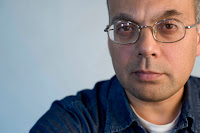To get you in the 'new music' mood, take a listen to our Spotify playlist of works by the composers we've commissioned in our 2015-16 season (including Bryce Dessner and Elena Langer). We've also asked the OPUS2016 shortlisted composers for their suggestions of what to start with if you're looking to explore more...
Daniel Kidane:
Don’t be scared to immerse yourself in to something new – you have nothing to lose but so much to gain.
Don’t be scared to immerse yourself in to something new – you have nothing to lose but so much to gain.

Robert Peate:
Anything and everything – just keep listening and be open to what you hear. Don’t worry about ‘understanding’, just experience it (more than once if you can).
There are some great pieces to begin with such as Berio’s Sinfonia or
Xenakis’ Rebonds but sometimes the best way in is to listen to more
experimental popular music. Anyone who enjoys a bit of Autechre shouldn’t
struggle with the best bits of Stockhausen or Boulez. There are also lots of
British composers who write music I still consider beautiful in quite a
traditional manner: take George Benjamin’s amazing Written on Skin for
example.

Andrew Thomas:
Find a sound/texture you like and follow how it develops during a piece - be open to all the parameters of sound available in contemporary music and embrace what you don’t understand - the music I most admire is the music I don’t understand!
 Andrew Baldwin:
Andrew Baldwin:
My advice would be to start with a composer(s) you know and
like, and list what musical ideas you like about them (what is common in their
music etc). Then consult with a music friend that knows of other composers that
use similar processes/ideas. Suddenly you will notice your listening repertoire
growing and discovering some great music. I created a Spotify playlist that my
teacher and I came up with of works that I would find interesting, and there
hasn’t been one piece that I haven’t taken something away from – as well as
discovering some new favourite contemporary composers.

Emma Wilde:
I think people should not be afraid. Most people have been
confronted with modern art in some way even without knowing it, they have probably
been to an art gallery or exhibition and modern music is no different. My
listening recommendations would include anything by Ligeti as I think that was
the first contemporary composer I really connected with. Also the German
composer and pianist Nils Frahm, his live shows are electric, he has a great
connection with the audience and is a really innovative composer and performer,
there are many good videos on YouTube.
Margaret Haley:
Tune in to Radio 3 programmes: Late Junction, and Hear and
Now. Listen with an open mind. Listen to recordings as much as you can, then
listen again. Music festivals can also provide a great way of sampling new
music, e.g. HCMF shorts.
 Sohrab Uduman:
Sohrab Uduman:Start with whatever is to hand and whatever grabs your interest for whatever reason, however seemingly profound or trivial it may appear to be. It is not life-threatening, will not cause you physical damage and will not, probably, change your political allegiance. It is art, a voyage, an adventure; an opportunity, at the very least, to step out of routine and ‘normative behaviour’ and experience something that should prove beautiful, moving, revelatory and subversive.

Gonçalo Gato:
An open mind and receptiveness to the fantastic, as opposed to the ordinary. Also, it is important to look for concerts that feature some sort of introduction carried out by music historians, musicologists, or composers themselves. This will provide context and prepare the listening experience for those who find it more difficult.

James Hoyle:
I don’t believe in starting with something ‘easy’ - I’d suggest to just throw yourself in, listening to as many different types of new music as possible. There’s such a wide variety out there so there is surely something for everyone.
At Lunch Four features Bryce Dessner's El Chan, Schumann's Piano Quartet Op.47 and a selection of Bartok's folksong-inspired Duos - Norwich Fri 8 Apr, Cambridge Tue 12 Apr & London Wed 13 Apr. Find out more.
Benjamin Grosvenor directs features Elena Langer's story of an impossible love, Mozart's Piano Concerto No.27 and a works by Bartok and Strauss - Bradford on Avon Sat 23 Apr, Cambridge Wed 27 Apr, Norwich Fri 29 Apr & London Sun 1 May. Find out more.

James Hoyle:
I don’t believe in starting with something ‘easy’ - I’d suggest to just throw yourself in, listening to as many different types of new music as possible. There’s such a wide variety out there so there is surely something for everyone.
At Lunch Four features Bryce Dessner's El Chan, Schumann's Piano Quartet Op.47 and a selection of Bartok's folksong-inspired Duos - Norwich Fri 8 Apr, Cambridge Tue 12 Apr & London Wed 13 Apr. Find out more.
Benjamin Grosvenor directs features Elena Langer's story of an impossible love, Mozart's Piano Concerto No.27 and a works by Bartok and Strauss - Bradford on Avon Sat 23 Apr, Cambridge Wed 27 Apr, Norwich Fri 29 Apr & London Sun 1 May. Find out more.



